Author: Site Editor Publish Time: 19-11-2025 Origin: Site











Legionella, a Gram-negative rod-shaped pathogenic bacterium, is widely distributed in natural water bodies and man-made water supply systems. It thrives in warm (20–45°C), humid environments with stagnant or slow-flowing water. Typical breeding grounds include hotel central air-conditioning cooling towers, hospital hot water circulation systems, commercial building drinking water networks, and household water heaters.
The bacterium primarily spreads through aerosols — when showerheads produce fine water mist or air-conditioning systems deliver cool air, Legionella can enter the human respiratory tract via aerosols, leading to Legionellosis.
Mild cases present flu-like symptoms such as fever and muscle aches; severe cases can cause severe pneumonia, respiratory failure, and even death. Data show that the mortality rate of Legionnaires’ disease ranges from 5% to 30%, posing a lethal threat especially to the elderly, infants, immunocompromised individuals, and patients with chronic diseases. The disease also has a certain degree of contagiousness. Once an outbreak occurs in a centralized water supply system, it can trigger cluster infections, seriously threatening public health safety.
Even more alarming is the highly concealed nature of Legionella contamination: conventional sensory indicators (color, odor, turbidity) cannot detect its presence in water, and the bacterium can survive in water for several months. Although municipal water is chlorinated at the treatment plant, residual chlorine gradually degrades during pipeline transport, making it difficult to ensure Legionella suppression at the point of use. In recent years, frequent Legionella outbreaks in densely populated facilities worldwide — such as hotels, medical institutions, and nursing homes — have highlighted the urgent need for effective Legionella prevention and control in water systems, as well as the critical demand for advanced, efficient water disinfection technologies.
In the face of the hazards posed by Legionella, effective water disinfection is the key to blocking its transmission.
The MASSPHOTON MP-UVC-10LB UVC LED Water Disinfection Module has delivered convincing results — verified by an independent third-party professional institution using standardized testing protocols, it achieves a 99.999% inactivation rate against Legionella, fully complying with relevant international drinking water safety standards and providing robust technical support for controlling pathogenic bacteria in water.
This outstanding result is no accident; it is a direct reflection of the module’s core technological advantages:
Precise and highly efficient sterilization wavelength The MASSPHOTON UVC LED Water Disinfection Module emits deep ultraviolet (UVC) light with a peak wavelength of 270–280 nm. This wavelength is strongly absorbed by the DNA/RNA of microorganisms (including Legionella), instantly destroying their genetic structure and preventing replication and survival — achieving “light-speed inactivation” without affecting the physical or chemical properties of the water.
Pure physical disinfection mechanism Based entirely on physical principles with no chemical additives throughout the process, it completely eliminates the risk of secondary pollution. Test data confirm that water treated by the module contains no additional chemical residues and fully complies with all water quality safety requirements in drinking water hygiene standards.
Instant-on, immediate effect Leveraging the propagation characteristics of UVC deep ultraviolet light, the module enables instantaneous disinfection of flowing water — a single pass through the disinfection channel at the designed flow rate completes the inactivation process, with no holding time required. This feature makes it ideal for applications demanding immediate disinfection, such as instant-hot drinking water devices, shower-end water supplies, and direct-drinking water purifiers, meeting continuous disinfection needs across diverse scenarios.
Environmentally friendly and energy-efficient The module employs solid-state UVC LED technology containing no mercury, lead, or other harmful substances, fully compliant with EU RoHS and other environmental directives, avoiding the disposal pollution risks associated with traditional mercury-based UV lamps. It also consumes less energy than conventional UV disinfection equipment, with a start-up response time of less than 1 second, significantly reducing standby power consumption and aligning with green, low-carbon industry trends.


Thanks to its verified 99.999% Legionella inactivation rate and excellent system compatibility, the module can be widely applied across multiple water disinfection scenarios:
In hotels: installed at guest-room showerheads and bathroom faucets to provide guests with safe domestic water.
In hospitals: integrated into hot water circulation systems and direct-drinking water equipment to effectively protect patients and healthcare workers and reduce nosocomial infection risks.
In office buildings and nursing homes: incorporated into drinking water networks and central air-conditioning cooling towers to suppress Legionella growth at the source and safeguard collective health.
In households: fitted to water purifiers and water heaters to build a personal water safety barrier for family members.
Whether in public water supply systems or domestic settings, the MASSPHOTON UVC LED Water Disinfection Module serves as a reliable technical component, delivering continuous, non-destructive, and highly efficient safety assurance for all water-use environments.
Although Legionella is stealthy and difficult to detect, it is far from uncontrollable. With a verified 99.999% inactivation rate, the MASSPHOTON UVC LED Water Disinfection Module fully demonstrates the practical value and future potential of UVC LED technology in the field of water safety. As efficient, safe, and environmentally friendly disinfection technologies like UVC LED become widely adopted, we will be able to more precisely counter the threat of waterborne pathogens, ensuring that every drop of water carries health assurance, building a solid defense line for public health safety and family well-being, and truly achieving the goal of “Safeguarding Water Source Safety, Defeating the Invisible Killer.”